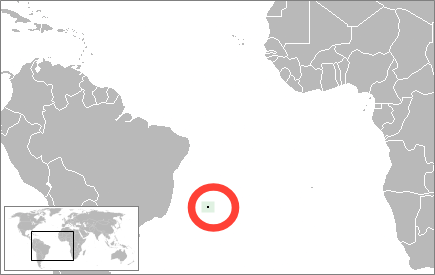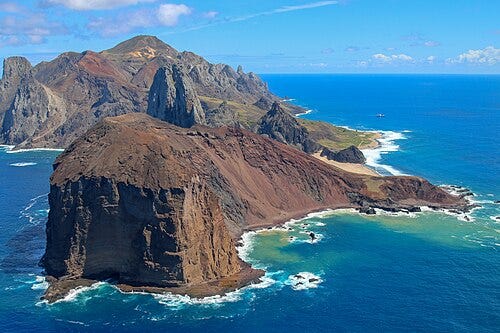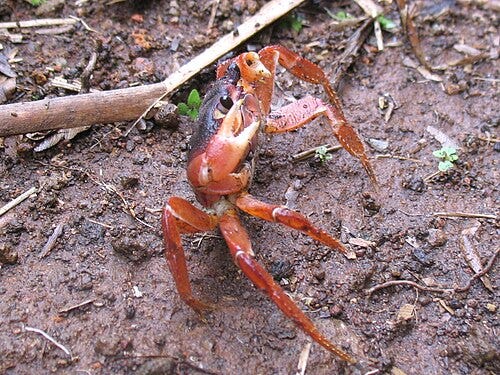Crabs!
Notes from a real South Pole expedition detail an unexpected hazard on the way down to the Antarctic
from The Worst Journey in the World by Apsley Cherry-Garrard
The story so far: In 1910, Apsley Cherry-Garrard set sail with Robert Falcon Scott’s Terra Nova Expedition to the South Pole. En route, the men stopped at a desert island 680 miles east of Brazil, formerly called South Trinidad (not to be confused with the Caribbean island of Trinidad), to take scientific observations of the interesting animals to be found there, including birds (gannets and terns)…
Now read on…
The gannets and terns were quite extraordinary, like all the living things there. If you stay still enough the terns perch on your head. In any case they will not fly off the rocks till you are two or three feet away. Several gannets were caught in the men's hands. All the fish which the biologist collected to-day can travel quite fast on land. When the Discovery was here Wilson saw a fish come out of the sea, seize a land crab about eighteen inches away and take it back into the water.
The land crabs were all over the place in thousands; it seems probable that their chief enemies are themselves. They are regular cannibals.

Then we did a real long climb northwards, over rocks and tufty grass till 1.30 p.m. From the point we had reached we could see both sides of the island, and the little Martin Vas islands in the distance.
We found lots of little tern and terns' eggs, lying out on the bare rock with no nest at all. Hooper also brought us two little gannets—all fluffy, but even at this age larger than a rook. As we got further up we began to come across the fossilized trees for which the island is well known.
Four or five Captain biscuits made an excellent lunch, and afterwards we started to the real top of the island, a hill rising to the west of us. It was covered with a high scrubby bush and rocks, and was quite thick; in fact there was more vegetation here than on all the rest we had seen, and in making our way through it we had to keep calling in order to keep touch with one another.

The tree ferns were numerous, but stunted. The gannets were sleeping on the tops of the bushes, and some of the crabs had climbed up the bushes and were sunning themselves on the top. These crabs were round us in thousands—I counted seven watching me out of one crack between two rocks.
We sat down under the lee of the summit, and thought it would not be bad to be thrown away on a desert island, little thinking how near we were to being stranded, for a time at any rate.
The crabs gathered round us in a circle, with their eyes turning towards us—as if they were waiting for us to die to come and eat us. One big fellow left his place in the circle and waddled up to my feet and examined my boots. First with one claw and then with the other he took a taste of my boot. He went away obviously disgusted: one could almost see him shake his head.

What we love about this…
The whole scene seems to be one taken from a horror film, and we might believe it to be an exaggeration or a tall tale, except that it comes from Cherry-Garrard’s first-hand notes. By including these immediate impressions unedited (or “unfiltered,” in contemporary speak), he seems to be telling us that the experience of seeing these terrifying creatures speaks for itself. He also includes an excerpt from a fellow sailor’s letter home to his mother, for good measure:
“The land-crabs are little short of a nightmare. They peep out at you from every nook and boulder. Their dead staring eyes follow your every step as if to say, 'If only you will drop down we will do the rest.' To lie down and sleep on any part of the island would be suicidal. Of course, Knight had a specially cleared place with all sorts of precautions, otherwise he would never have survived these beasts, which even tried to nibble your boots as you stood—staring hard at you the whole time. One feature that would soon send a lonely man off his chump is that no matter how many are in sight they are all looking at you, and they follow step by step with a sickly deliberation. They are all yellow and pink, and next to spiders seem the most loathsome creatures on God's earth.”
Once in Antarctica, and also in the name of science, Cherry-Garrard would journey by foot across the continent to retrieve Emperor penguin eggs—this is the “worst journey in the world” of the book’s title.
About the author
Apsley Cherry-Garrard (1886-1959) best known as an Antarctic explorer and part of one of the teams which accompanied Captain Scott on his attempt to reach the South Pole. Cherry-Garrard’s team was sent back before the final push; those men who did reach the Pole—Scott, Lawrence Oates, Edward Wilson, Henry Bowers, and Edgar Evans—all tragically perished on their return journey from it.
To read alongside…
Cherry-Garrard suggested the line from the poet Tennyson—“To strive, to seek, to find, and not to yield”—be inscribed on the cross at Observation Hill, Antarctica memorializing the lost polar party. See our newsletter dedicated to this poem:
Suggest a LitHit!
Tell us your own favourites from literature you've read, and we can feature you as a Guest Curator. Just email us with the following information:
Your full name
The title of the book you're suggesting
The location of the excerpt within the book (e.g., "in the middle of chapter 5"), or the excerpt itself copied into the email or attached to it (in Word)
Why you love it, in just a few sentences
About LitHits
LitHits helps you make time for reading by bringing you unabridged excerpts from brilliant literature that you can read on the go, anytime or any place. Our curators carefully select and frame each excerpt so that you can dive right in. We are more than a book recommendation site: we connect you with a powerful, enduring piece of literature, served directly to your mobile phone, tablet or computer.
You might also enjoy...
Feedback
We'd love to hear your thoughts on our newsletter:
kshepherdb@yahoo.co.uk
Graphic design by Sara Azmy
All curation content © 2025 LitHits. All rights reserved.




